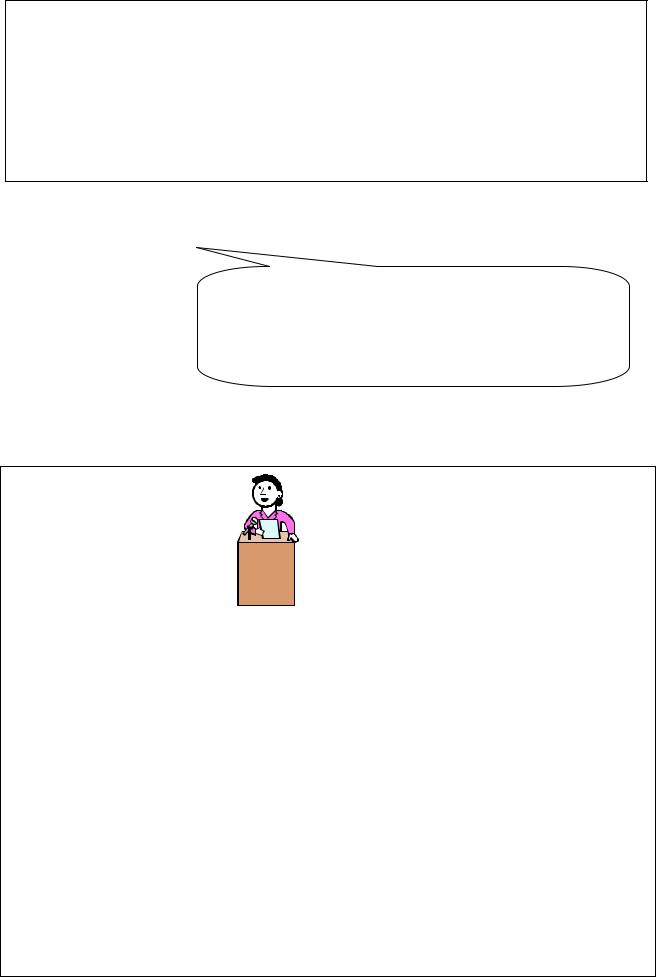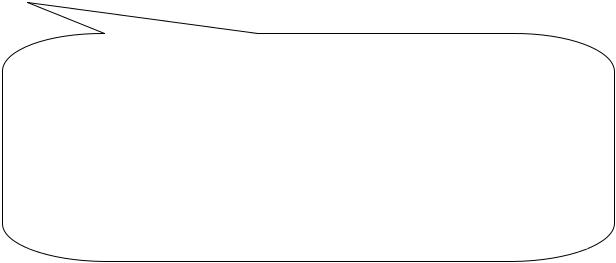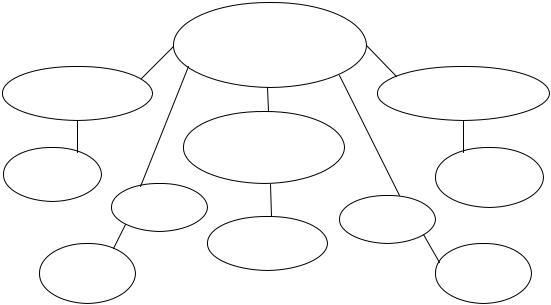
ENGLISH for Study and Work том 1
.pdfBang! 1. something that you say or do at the beginning that gets the attention of the audience: a visual aid, a story, a joke, a surprising fact, a reference to 'here and now' (the audience, the place, etc).
Opening 2. use practical, easy-to-understand evidence to make your points clear.
Message 3. make it clear to the audience how your message connects to their needs / interests.
Bridge 4. a summary of your main points.
Examples 5. the main points of your presentation. Decide on just three key points at the planning stage and write them down as three short sentences. This will focus your mind, and more than this will be hard for the audience to remember. Perhaps use these three sentences as the final slide in your presentation.
Recap 6. thanking the organizers for inviting you, a few words about yourself, telling the audience the topic and structure of your presentation, making it clear whether questions should be kept to the end or not.
Bang! 7. a link back to your first Bang! to give a sense of closure.*
_____________________________________________________________
*Emmerson, P. (2007) Business English Handbook Advanced. The whole of business in one book. Oxford: Macmillan Education, p. 60.
10. Whole-group discussion. Taking into account the information from the unit think about how well you are prepared for speaking in public and what you should do to develop your own presentation skills. Be ready to give a short presentation in front of your groupmates using the presentation structure in 9, corresponding phrases from handout in 6 and tips from handout in 7.
2100987

Unit 2 Making a Start
Focus on
•introducing yourself
•introducing the topic of a presentation
•talking on the purpose of a presentation
•outlining your talk
•developing a speech introduction
By the end of the unit you will:
•be aware of what makes a good introduction
•be aware of the function(s) of an introduction
•be able to state the purpose of an introduction
•be able to use appropriate phrases for making an introduction
•be aware of the ways of catching immediate attention
Lead-in
1.Pair-work. Paraphrase the following proverbs. Think about:
•Do they mean the same?
•Do you agree with their meanings?
Discuss your ideas with a partner. Share your ideas with the other pair using examples from your own experience.
A good beginning is half the battle.
A good beginning makes a good ending.
211098

2. In groups of four sum up your ideas and think to what extent the following things contribute to the effectiveness of a speech introduction. Be ready to give a short presentation on the role of an opening using the items given below as key words and phrases.
• clear organization |
• stating the purpose |
• introducing oneself |
• catching attention |
• identifying the audience |
• initial impression |
• subject |
• presentation outline |
Opening a presentation
3. Which of the items on the worksheet below would you include in the introduction to an internal presentation to your groupmates/colleagues? Tick (√) those you have chosen. What does your choice depend on?
WORKSHEET 4.2
•your name and position
•department
•job responsibilities
•the title/subject of your presentation
•the purpose of your presentation
•the length of time you will take
•the main parts or points you will cover
•any visual aids you will use
•when the audience may ask questions
•a reference to the audience: a human touch
212309

Introducing the topic
4. Choose from the following to introduce the subject of your presentation. Remember you are preparing a presentation to your groupmates/colleagues. What other information do you need to make a right choice?
I’d like to |
|
talk (to you) today about … |
||||
I’m going to |
|
present the recent …. |
||||
|
|
|
|
explain our position on … |
||
|
|
|
|
inform you about … |
||
|
|
|
|
describe … |
||
The |
|
subject |
|
of my |
|
talk…. |
|
|
|
||||
|
|
|
||||
|
|
focus |
|
|
|
presentation |
|
|
topic |
|
|
|
paper (academic) |
|
|
|
|
|
|
speech (to public audience) |
|
|
|
|
|
|
|
Reading for specific information
5. Read carefully the information about specifying the purpose of a presentation. Answer the following questions:
•What may the purposes of presentations be? Think about different types of presentations.
•When do you need to state the aim of a presentation? What does it depend on?
•Add your own ideas.
213240

 For You to Know: Stating the Purpose of your Presentation
For You to Know: Stating the Purpose of your Presentation
To make your presentation effective it is essential to have a clear idea of what you want to achieve.
E.g. Do you want to inform your audience about essential facts, or to persuade them to accept your proposal? This main purpose or aim needs to be briefly stated in the opening part of a presentation.
Use the following expressions for stating the purpose/objective:
We are here today to |
|
|
learn about … |
|
|
|
decide … |
|
|
|
agree … |
The purpose of this talk is to |
|
update you on … |
|
|
|||
|
|
put you in the picture about … |
|
|
|
give you the background to … |
|
This talk is designed to |
|
act as a springboard for |
|
|
|||
|
|
discussion. |
|
|
|
start the ball rolling. |
|
You can state the purpose right at the beginning or by building up gradually, leaving your statement of purpose until the latter part of the introduction. Both ways can be equally effective.
State the purpose of your own presentation using one of the following:
In my presentation today I’m going to explain the technical problems involved in….
This morning I’d like to review progress on….
In my presentation I’ll be proposing two new techniques which we need to incorporate in….
In my presentation today I’d like to summarize the main findings of the
214235

Create more impact by changing the normal word order. Begin your statement of purpose with the word “what”.
What I’m going to explain today are the technical problems involved in….
What I’d like to do this morning is present the results of our study. What I’ll be proposing in my presentation are two new techniques ….
6. Inform the audience about the length of your presentation. Choose one from the following:
I shall only take … minutes of your time.
I plan to be brief.
This should only last … minutes.
7. Read the information given in the box below.
For You to Keep in Mind
Introduction of a Presentation
Remember! Many successful introductions include information about the main points to be developed during the presentation, and the order in which the presenter will develop these. It is called signposting.
Your introduction should contain some kind of signposting for the audience.
Signposting your presentation will help you define the limits of your presentation, and focus the audience on the aspects of the topic you want to talk about. Tell them what you will be talking about, and in which order you will develop your points.
215346

8. Use the following expressions for signposting your presentation, outlining its development and organizing the information. Choose the appropriate ones for preparing a presentation to your groupmates.
I’ll be developing three main points. First, I’ll give you…. Second, …. Lastly, ….
My talk will be in...
I’ve divided my presentation into four parts/sections. They are: …. The subject can be looked at under the following headings: …. We can break this area down into the following fields: ….
9. Invite questions while introducing your talk.
I’d be glad to answer any questions at the end of my talk. If you have any questions, please feel free to interrupt.
Please interrupt me if there’s something which needs clarifying. Otherwise, there’ll be time for discussion at the end.
Follow-up
9. Group-work. You are going to prepare and make a speech introduction on the topic “Latest advances in communications and their influence on different spheres of our life”. Follow the tips and use appropriate functional phrases from the unit.
2167543
Unit 3 Organising a Presentation
Focus on
•organising information and ideas
•key elements of a public speech
•structuring an effective presentation
•functions and functional phrases for presentations
•phrases used for linking ideas and parts of a presentation
By the end of the unit you will:
•be able to organise your ideas on chosen topic
•be able to identify the purpose of a presentation
•be able to consider the target audience
•be aware of words and phrases for structuring a presentation
Lead-in
1. Pair-work. Think about the last really successful presentation that you attended.
•Was that easy to remember?
•What features helped you to remember it?
•What was the reason the presenter gave the talk? Share your ideas with the whole group.
Reading and Discussion
2. Read carefully the information given on the following page. Pay attention to the fact that preparation is one of the most important factors in determining your communication success.
2178654

For You to Know: Understanding What You Want to Achieve
Before you start working on your talk or presentation, it's vital that you really understand what you want to say, who you want to tell and why they might want to hear it.
To do this, ask yourself:
Who are you speaking to? What are their interests, presuppositions and values? What do they have in common; how are they different?
What do you wish to communicate? To provide your audience with this information, you should determine your message: What is the single most important thing you want your audience to understand, believe, accept, or do after they hear you?
How can you best convey your message? Language is important here, as are the nonverbal cues. Choose your words and your nonverbal cues with your audience in mind. Plan a beginning, middle and end. If time and place allow, consider and prepare audio-visual aids.
When? Timing is important here. Develop a sense of timing, so that your contributions are seen and heard as relevant to the issue or matter at hand. There is a time to speak and a time to be silent.
Where? What is the physical context of the communication in mind? You may have time to visit the room, for example, and rearrange the furniture. Check for availability and visibility if you are using audio or visual aids.
Why? In order to convert hearers into listeners, you need to know why they should listen to you – and tell them if necessary. What disposes them to listen? That implies that you know yourself why you are seeking to communicate – the value or worth or interest of what you are going to say.
2189765

3. In small groups, compare the tips from the text you have read with your own ideas in 1. What information is the most important and useful for you? Be ready to present your viewpoint in the whole-group discussion.
Organising information
4.Group-work. Think about different ways of organising information and ideas while preparing a presentation. Use the following steps to develop a clear plan for your talk:
•Brainstorm the topic to clarify what you know
•Organise the material logically, eg. chronologically, spatially (diagrams and mind-maps), sequentially (first, second), etc.
•Develop a plan or structure.
5.Now choose one of the following topics and brainstorm your ideas using your notes in 4 and the mind-map given bellow as an example. You may use the information from the text on the following page, the mind-map and texts in Part II Self-study Resources. Share your ideas with your groupmates.
1.Chinese mining ambitions
2.Top-priority challenges of the mining sector
3.Negative impacts of mining activities
|
Major problems in |
|
coal-mining sector |
Outdated assets |
Safety problems |
High production costs
21920876
